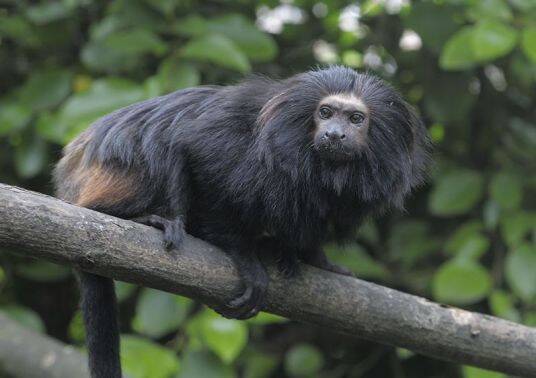Leontopithecus chrysopygus
IUCN
LCBasic Information
Scientific classification
- name:Leontopithecus chrysopygus
- Scientific Name:Leontopithecus chrysopygus,Black Lion Tamarin,Golden-rumped lion tamarin, yellow-tailed lion tamarin, golden-rumped lion tamarin, golden-rumped lion tamarin
- Outline:Primates
- Family:Marmoset L.Tamarin
Vital signs
- length:22-26cm
- Weight:540-690g
- lifetime:No verification information
Feature
Reddish-gold fur in varying degrees on the lower back, rump, thighs, and base of the tail
Distribution and Habitat
It is only found in the Sao Paulo National Park in Brazil. The black lion tamarin was thought to be extinct after 1905 until it was rediscovered in 1970 in the southwest of Sao Paulo. At that time, it was estimated that there were less than 100 individuals. As of 2008, there are about 6 known populations, and the number of individuals remaining is estimated to be less than 1,000. The wild habitat is mainly tropical primary forests. It is usually active in the middle and canopy layers of large trees 3-10 meters above the ground, and lives in the intertwined branches under the cover of dense vines and other parasitic plants.
Appearance
The black lion tamarin has a head and body length of 22-26 cm, a tail length of 33-40 cm, and a weight of 540-690 grams, which is about the same size as a squirrel. It is one of the most endangered mammals in the world. Also known as the golden-rumped lion tamarin, this species has shiny black fur all over its body, with varying degrees and amounts of reddish-gold fur on the lower back, buttocks, thighs, and the base of the tail. The long mane is black, and the whole body is covered with shiny black velvety soft long hair, which is eye-catching. The lion-like crest on the head brushes against the back, the mouth protrudes forward, and the ears are hidden under the hair. The appearance is dignified and majestic, just like a little lion, very beautiful and moving. Its front and rear limbs are about the same size. Its body and hands and feet are longer than those of other marmosets. There is a membrane between the second, third and fourth fingers, forming a webbed shape. Except for the th
Details
Black Lion Tamarin (scientific name: Leontopithecus chrysopygus) is also known as Black Lion Tamarin, and has no subspecies.

The black lion tamarin is a diurnal arboreal animal. It is active and lively, with keen vision, hearing and smell. It is agile and extremely agile. It can leap from one tree to another tree far away in an instant, or run quickly along the trunk or branches. Some of its difficult movements are not only difficult for other monkeys to complete, but even squirrels cannot catch up. Lion tamarins usually live in small-scale family-style groups, with 2-8 in each group, and 3-4 is the most common. Most of them are a pair of adults and their cubs, often gathering together to comb each other's beautiful golden long hair. They sleep in tree holes every night. Because the hole is very narrow, ordinary carnivores cannot enter, which can effectively avoid enemies. The tree hole is also covered with golden soft hair pulled from its body, which is both beautiful and comfortable, so a tree hole can be used for its habitat for many years.
The black lion tamarin is an omnivorous animal, foraging for various insects, spiders, moths, flies, grubs, worms, and tender shoots, flowers and fruits of various plants, etc., especially figs. Sometimes it digs earthworms and small lizards on the ground, and sometimes it forages for bird eggs in trees, and even preys on newly born birds. In addition, in the forest where it lives, many trunks or branches are covered with holes of various sizes. This is because it likes to suck the sap of trees. It often uses its sharp claws to dig holes in the trunks or branches, or bites with its powerful incisors, and then sucks the sap flowing out into its mouth with relish.
The breeding season of black lion tamarins is concentrated from September to March of the following year, that is, from early spring to late summer, which is the most humid and hot season in the area. The gestation period of females is 125-134 days, and each litter has 1-3 cubs, but 2 cubs are the most common. The cubs are mostly taken care of by males, and they can move independently after growing to 3 months.
Most South American countries have banned or limited exports and established national parks and nature reserves to effectively protect these rare species. For example, Brazil has stopped exporting lion tamarins since 1969 and has significantly increased the scope of protection for primates. Despite this, the future of these beautiful little primates remains worrying.
Listed in the 2008 Red List of Endangered Species of the World Conservation Union (IUCN) ver3.1 - Endangered (EN).
Listed in Appendix I of the Washington Convention on International Trade in Endangered Species (CITES).
Protect wildlife and eliminate game.
Maintaining ecological balance is everyone's responsibility!








